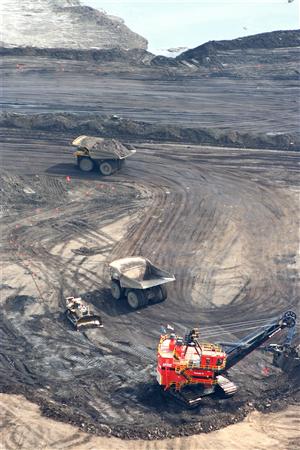The Oil Sands Described
Oil sands are deposits of sand or clay mixed with water and bitumen, a naturally occurring, viscous mixture of hydrocarbons. Through complex industrial processes, bitumen can be separated from the sands and processed into synthetic crude oil, one of the most important energy sources in the world. Synthetic crude oil originating from the Alberta oil sands is refined for use as gasoline, jet fuel, home heating fuels, and numerous other products (OSDC 2008a). Two tonnes of oil sand is required to produce one barrel of upgraded synthetic crude oil.
Alberta contains the second largest proven concentration of oil in the world, surpassed only by the Saudi Arabia reserves (Government of Alberta 2008b). Most of Alberta’s oil resources are found in the oil sands, which cover approximately 140,000 km2 in three areas of northeastern Alberta: the Athabasca, Peace River, and Cold Lake regions. Under today’s economic conditions and technologies, Alberta’s oil sands contain over 173 billion barrels of recoverable oil, with an estimated total of 315 billion barrels of potentially recoverable oil in the oil sands. In 2006, the oil sands accounted for approximately 62% of Alberta’s total crude oil and equivalent production (Alberta Energy 2008).
The oil sands are thought to have originated from the northeasterly migration of oil from southern Alberta into existing sand deposits left behind by ancient river beds (OSDC 2008b). This migration was driven by the same pressures associated with the formation of the Rocky Mountains. Over time, the actions of bacteria and water transformed this light crude oil into bitumen. Today, the oil sands are found primarily in the McMurray formation, a layer of rock consisting of shale, sandstone, and oil-impregnated sands up to 150 m thick in some locations. The McMurray formation is overlain by other layers of rock (i.e., the Clearwater and Grand Rapids formation), but the depth of the McMurray formation below the earth’s surface is highly variable. North of Fort McMurray, oil sands can be found within 75 m of the surface and, in some locations, are even exposed at the surface where rivers have incised into the landscape (Conly et al. 2002).
The layer of rock, soil, vegetation, and muskeg overlying the oil sands is known as the overburden. Where the layer of overburden is relatively shallow (i.e., less than 75 m), the oil sands can be recovered through surface mining, while deeper-lying bitumen must be extracted using in situ (in place) methods. Using current technologies, only about 20% of Alberta’s oil sands are recoverable by mining, with the remainder accessible only by in situ technologies (Government of Alberta 2008b).
The Athabasca oil sands deposit is the largest of Alberta’s three oil sands deposits, and covers an area of approximately 40,000 km2. This deposit contains the most bitumen, and is the only deposit with reserves shallow enough to be surface mined. As of 2008, numerous oil sands mines and in situ projects are operational north of Fort McMurray.









